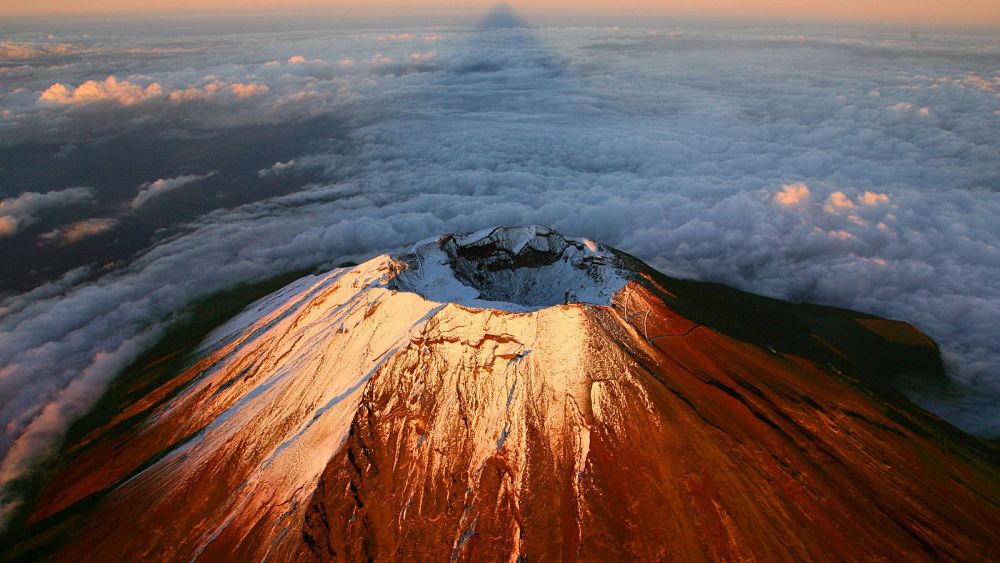The presence of tiny plastics in clouds risks the contamination of ‘everything we eat and drink’, researchers say.
Microplastics have been discovered in clouds, where scientists say they could be contributing to climate change.
Researchers found several types of polymers and rubber in the water in cloud water surrounding Mount Fuji, Japan’s biggest mountain, and Mount Ōyama.
Their study, published in the journal Environmental Chemical Letters, joins a growing body of evidence showing that plastic pollution has infiltrated most ecosystems on Earth.
Fragments of plastic smaller than 5mm (around the size of a sesame seed) have been found in the furthest reaches of the planet and most intimate parts of the human body, including the blood, lungs, and placentas of pregnant women.
"To the best of our knowledge, this study is the first to detect airborne microplastics in cloud water in both the free troposphere and atmospheric boundary layer,” the scientists wrote.
So I guess buying a water filter for my tap at home isn’t going to save me.
Nope, good news is nobody knows what the harm is, yet!
This is also the bad news.
I thought I remember hearing something about plastic affecting men’s testosterone is that not true?
Some water filters actually increase the level of microplastics.
Condensation nuclei are tiny particles upon which water vapour condenses in the atmosphere, meaning they’re essential for the formation of clouds.
“Overall, our findings suggest that high-altitude microplastics could influence cloud formation and, in turn, might modify the climate,” the scientists wrote.
How might it modify the climate? I thought cloud seeding was a proposed geoengineering technique to mitigate climate change?
Yeah but if we do by accident everywhere on earth continuously, it probably isn’t going to be like… a net positive.
Probably not, but I asked how it works
When’s they say “it might modify the climate”, it means that we need to study it more to understand it better. Clouds determine precipitation and can cause heating or cooling depending on specific factors. It could be a net positive, or it could (far more likely) be a net negative. What makes climate change so bad is not so much based on temperature as it is based on change. Any change significantly affects crop yields, precipitation, and biodiversity. Whether the planet was getting hotter or colder, plenty of plants, humans, and other animals will die in the process.
Though tiny, aerosols have an oversized influence on climate. The murk of anthropogenic aerosols in the sky has, overall, had a dramatic cooling effect since the Industrial Revolution (without them, global warming would be 30 to 50 percent greater than it is today). And they have more sway on extreme weather than greenhouse gases do: a world warmed by removing aerosols would have more floods and droughts, for example, than a world warmed the same amount by CO2.
Revell and her colleagues took a stab at trying to model how microplastics might affect temperature by either reflecting or absorbing sunlight, a calculation of what’s known as “radiative forcing.” For simplicity’s sake, they assumed that plastic is always clear, even though that’s not true (and darker material tends to absorb more sunlight), and that the global concentration is uniformly one particle per cubic meter, which is on the order of 1,000 times lower than concentrations measured in, say, London.
With those assumptions, Revell found that plastic’s direct impact on radiative forcing is “so small as to be insignificant.”
https://e360.yale.edu/features/plastic-waste-atmosphere-climate-weather
The original post is discussing cloud formation not aerosol concentrations. Clouds can reflect solar energy away from us, but they can also maintain higher temperatures by acting like a blanket. Also, precipitation patterns will change even more rapidly and unpredictably. Again, we need more research on this specific phenomenon. Because it might become problematic.
As is the link I posted, aerosols are the same thing, a suspension of particles
Recent studies reveal that tiny pieces of plastic are constantly lofted into the atmosphere. These particles can travel thousands of miles and affect the formation of clouds, which means they have the potential to impact temperature, rainfall, and even climate change.
Clouds form when water or ice condenses on “seeds” in the air: usually tiny particles of dust, salt, sand, soot, or other material thrown up by burning fossil fuels, forest fires, cooking, or volcanoes. There are plenty of these fine particles, or aerosols, in the skies — a lot more since the Industrial Revolution — and they affect everything from the quality of the air we breath, to the color of sunsets, to the number and type of clouds in our skies.
You originally asked how cloud formation changes the climate and now you’re answering your own question?
Whether it heats or cools the earth, it is still changing the climate. Either direction is a dangerous change that can rapidly deteriorate our already precarious situation in regards to climate change.
I don’t understand what you’re saying by posting these links?
LOL Couldn’t have said it better
Marine cloud seeding/brightening, aims to make clouds more reflective, to reflect sunlight back away from Earth. Not sure microplastics from tyre rubber are likely to have that effect.
Anybody know of a way to reduce micropastic pollution from tires that isn’t parking your car? It seems like an inevitable side effect of all tires.
This is the best summary I could come up with:
Their study, published in the journal Environmental Chemical Letters, joins a growing body of evidence showing that plastic pollution has infiltrated most ecosystems on Earth.
Fragments of plastic smaller than 5mm (around the size of a sesame seed) have been found in the furthest reaches of the planet and most intimate parts of the human body, including the blood, lungs, and placentas of pregnant women.
"To the best of our knowledge, this study is the first to detect airborne microplastics in cloud water in both the free troposphere and atmospheric boundary layer,” the scientists wrote.
"Microplastics in the free troposphere are transported and contribute to global pollution,” says lead author of the research, Hiroshi Okochi of Waseda University.
“If the issue of ‘plastic air pollution’ is not addressed proactively, climate change and ecological risks may become a reality, causing irreversible and serious environmental damage in the future.”
“This implies that microplastics may have become an essential component of clouds, contaminating nearly everything we eat and drink via ‘plastic rainfall’," according to a statement about the study from Waseda University,
The original article contains 601 words, the summary contains 179 words. Saved 70%. I’m a bot and I’m open source!






